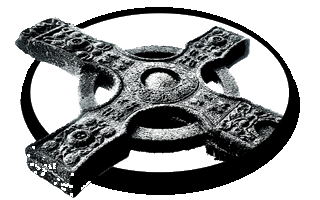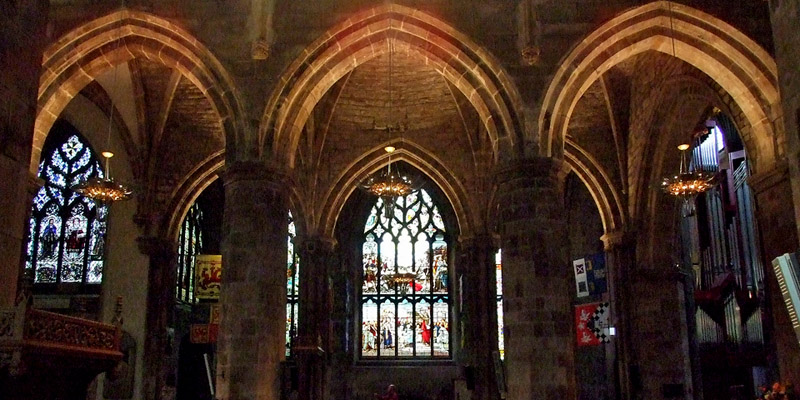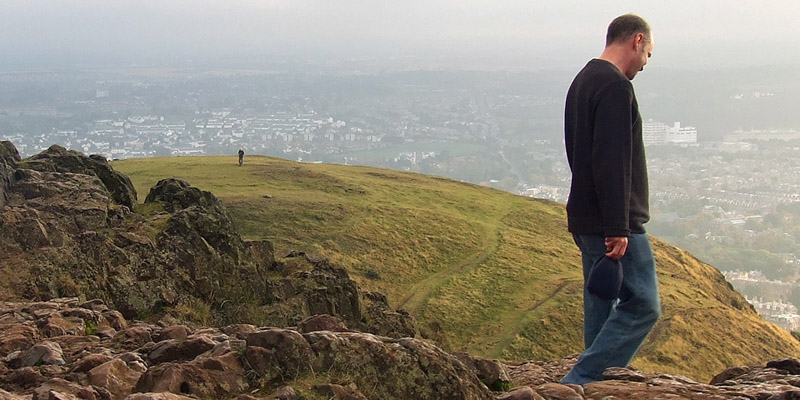
from Holy Island to the Isle of Iona


8 October 2010
The North Atlantic Arc Home
| September | /October/ | November |
| S | M | T | W | T | F | S |
| 27 | 28 | 29 | 30 | 1 | 2 | |
| 3 | 4 | 5 | 6 | 7 | 8 | 9 |
| 10 | 11 | 12 | 13 | 14 | 15 | 16 |
| 17 | 18 | 19 | 20 | 21 | 22 | 23 |
| 24 | 25 | 26 | 27 | 28 | 29 | 30 |
| 31 | 1 |
 |
|
Friday 8 October 2010--We catch the bus up to the Royal Mile after breakfast. Today is Scott's first full day in Scotland, and
Win's first visit to Edinburgh, as well. I am, in essence, the host, and I feel some pressure to make it all worthwhile.
Edinburgh sells itself. We start simply by soaking up some atmosphere, which, for better or worse, includes a lot of ticky-tacky
souvenir shops along the Mile. We are inevitably drawn to the castle. I've been here before, of course, but am happy to revisit
it--there's a lot to see, and I always find something I haven't seen before. Win and Scott seem particularly to enjoy locking
themselves into a military prison cell. The 12th-century St Margaret's Chapel, oldest surviving structure in the castle, is
another highlight.
A signboard at a parapet overlooking the New Town explains how the layout of the 18th-century development celebrates the union of Scotland and England. The central George Street was named after the king; parallel Queen and Princes Streets, for his wife, Charlotte, and sons. Rose Street and Charlotte Square stand for England, and Thistle Street and St Andrew Square, for Scotland. We are often given the impression that Scotland is a conquered and subjugated nation, but history casts a different light on the matter. The two countries had shared a monarch since the death of Elizabeth I in 1603, when Mary Queen of Scots' son, James VI of Scotland and I of England, took the throne. The Treaty of Union was ratified by both the Scottish and English parliaments in 1706. Intervening events were messy, to say the least, involving conflict between Catholics and Protestants, Presbyterians and Anglicans, Royalists and Covenanters, with the Jacobite rebellions yet to come. Rarely, if ever, was any of this a straightforward matter of Scots versus English. We lunch in the castle café--pretty nice for what it is--and stroll on down the Mile. It's always good to have fresh company in familiar places, forcing you to look at things anew. Somehow, in all the years I've been coming here, I've never set foot in St Giles Cathedral. There has been a church here since the 12th century, at least, but the edifice has gone through an extraordinary amount of expansion, reconstruction, modification, reuse, and renovation over the centuries, continuing right up through the 20th century. Its life as an actual cathedral was limited to two brief periods in the 17th century, and for most of its existence, the interior space was divided up as three or even four separate churches, as well as, at one point, a police office and a firehouse. Major renovations and restoration took place through the 19th century, creating what we see now, for the most part. Mark is in at the Cadenhead's shop, and we have a fairly lengthy whisky blether. He is generous with samples. Win and Scott decide to share a bottle of 17-year-old Bladnoch, a dram of which we had at the Bow last night. Mark agrees to bring the bottle to the Bow later, as we don't want to carry it around just now. That's service. We'll ply him with pints, of course. I'll be back in town later, and will buy a couple of bottles then. I really wish I could buy more bottles here--I like Cadenhead's a lot, and Mark always goes the extra mile. If you're in Edinburgh and have any appreciation for single malt whisky, you really should check it out. A little farther down the street is a pipemaker's shop. Win, a talented flutist, fueled perhaps by Cadenhead's samples, wonders aloud whether they might allow him to try his hand at the bagpipes. In we go. It seems to be a slow afternoon, and the shopkeeper indulges him. Shortly the shop assistant is rushing to close the door, lest anyone outside be inadvertent witness to the hilariously inexact translation of flute skills to the highland pipes. Scott and I are in hysterics. The shop staff are remarkably tolerant, answering our questions seriously, and explaining technique and musical matters insofar as it is possible in the time we spend there. I learn quite a bit, deepening my appreciation of pipe music. The pipes nominally have only nine notes, but the complex fingering techniques for the multitude of grace notes are beyond my comprehension. Win rewards the shopkeeper's patience by purchasing a practice chanter. Scott buys one, too, for his teenage son, who is curious about all things musical. Shortly we are at the foot of the Royal Mile, with Holyrood Palace and the Scottish Parliament (two more edifices I've yet to set foot in) on either side of us. We pass these by, instead entering Holyrood Park and ascending to the volcanic knob of Arthur's Seat. It's not a great day to be up here, overcast with a very hazy atmosphere. I miss the view out across the Firth of Forth to Fife, but the lads don't. We are down not long before sunset, and we all have the feeling that it's been a very satisfying day. I lead the boys over through the University, skirting the Meadows on the way, and then past the Museum on our way to Greyfriars Bobby's. We have a decent pint or two along with a serviceable dinner, and then head up to the Bow Bar. We are later than we'd intended, and Mark has been and gone, but the lads' bottle of Bladnoch is safe behind the bar. I owe Mark a couple of pints. We don't stay too late--we're all nodding off in our pints. Walking out the front door of the Bow, we step virtually into the path of a cab driving up from the Grassmarket. Easy as that. Next |
 |
Edinburgh
 |
Edinburgh Castle
 |
Edinburgh Castle
 |
Edinburgh Castle
 |
Edinburgh Castle
 |
Edinburgh Castle
 |
St Margaret's Chapel
 |
 |
 |
St Margaret's Chapel
 |
Edinburgh Castle
 |
Edinburgh Castle
 |
Edinburgh Castle
 |
St Giles Cathedral
 |
 |
 |
St Giles Cathedral
 |
St Giles Cathedral
 |
 |
 |
St Giles Cathedral
 |
Win Tortures Helpless Kittens
 |
Arthurs Seat
 |
St Anthony's Chapel
 |
Above Edinburgh
 |
Arthurs Seat
 |
Arthurs Seat
 |
God Rays
 |
Summit
 |
Holyrood Park
Next
| September | /October/ | November |
| S | M | T | W | T | F | S |
| 27 | 28 | 29 | 30 | 1 | 2 | |
| 3 | 4 | 5 | 6 | 7 | 8 | 9 |
| 10 | 11 | 12 | 13 | 14 | 15 | 16 |
| 17 | 18 | 19 | 20 | 21 | 22 | 23 |
| 24 | 25 | 26 | 27 | 28 | 29 | 30 |
| 31 | 1 |
The North Atlantic Arc Home

Mr Tattie Heid's Mileage
Results may vary